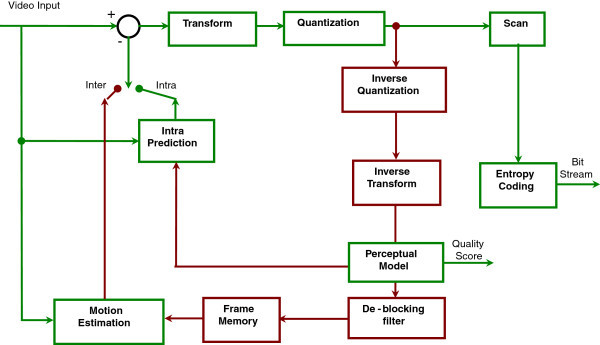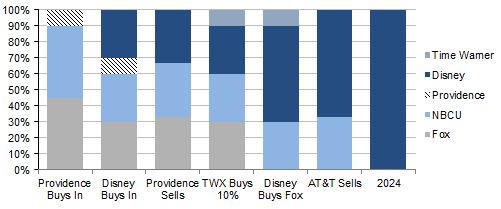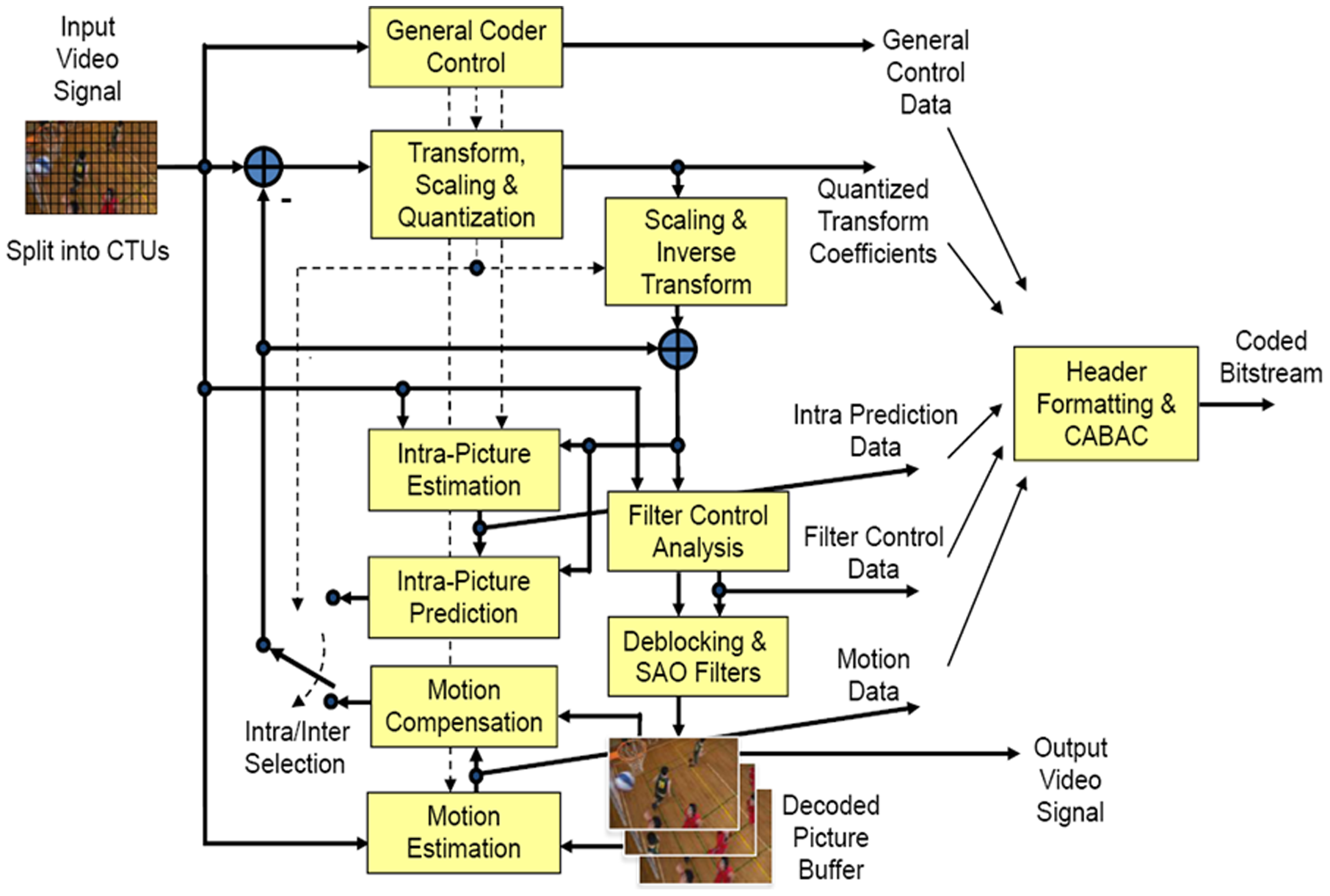|
Avc1
Advanced Video Coding (AVC), also referred to as H.264 or MPEG-4 Part 10, is a video compression standard based on block-oriented, motion-compensated coding. It is by far the most commonly used format for the recording, compression, and distribution of video content, used by 84–86% of video industry developers . It supports a maximum resolution of 8K UHD. The intent of the H.264/AVC project was to create a standard capable of providing good video quality at substantially lower bit rates than previous standards (i.e., half or less the bit rate of MPEG-2, H.263, or MPEG-4 Part 2), without increasing the complexity of design so much that it would be impractical or excessively expensive to implement. This was achieved with features such as a reduced-complexity integer discrete cosine transform (integer DCT), variable block-size segmentation, and multi-picture inter-picture prediction. An additional goal was to provide enough flexibility to allow the standard to be applied to ... [...More Info...] [...Related Items...] OR: [Wikipedia] [Google] [Baidu] |
ITU-T
The International Telecommunication Union Telecommunication Standardization Sector (ITU-T) is one of the three Sectors (branches) of the International Telecommunication Union (ITU). It is responsible for coordinating Standardization, standards for telecommunications and Information Communication Technology, such as X.509 for cybersecurity, Y.3172 and Y.3173 for machine learning, and H.264/MPEG-4 AVC for video compression, between its Member States, Private Sector Members, and Academia Members. The World Telecommunication Standardization Assembly (WTSA), the sector's governing conference, convenes every four years. ITU-T has a permanent Secretariat (administrative office), secretariat called the Telecommunication Standardization Bureau (TSB), which is based at the ITU headquarters in Geneva, Switzerland. The current director of the TSB is Seizo Onoe (of Japan), whose 4-year term commenced on 1 January 2023. Seizo Onoe succeeded Chaesub Lee of South Korea, who was director from 1 J ... [...More Info...] [...Related Items...] OR: [Wikipedia] [Google] [Baidu] |
Broadcasting
Broadcasting is the data distribution, distribution of sound, audio audiovisual content to dispersed audiences via a electronic medium (communication), mass communications medium, typically one using the electromagnetic spectrum (radio waves), in a :wikt:one-to-many, one-to-many model. Broadcasting began with AM radio, which came into popular use around 1920 with the spread of vacuum tube radio transmitters and radio receiver, receivers. Before this, most implementations of electronic communication (early radio, telephone, and telegraph) were wikt:one-to-one, one-to-one, with the message intended for a single recipient. The term ''broadcasting'' evolved from its use as the agricultural method of sowing seeds in a field by casting them broadly about. It was later adopted for describing the widespread distribution of information by printed materials or by telegraph. Examples applying it to "one-to-many" radio transmissions of an individual station to multiple listeners appeared as ... [...More Info...] [...Related Items...] OR: [Wikipedia] [Google] [Baidu] |
Hulu
Hulu (, ) is an American Subscription business model, subscription streaming media service owned by Disney Streaming, a subsidiary of the Disney Entertainment segment of the Walt Disney Company. It was launched on October 29, 2007, initially as a joint venture between News Corporation (later 21st Century Fox) and NBCUniversal, NBC Universal, which was later Acquisition of NBC Universal by Comcast, bought by Comcast. Many companies like AT&T's WarnerMedia, Providence Equity, and the Walt Disney Company bought stakes in the service. Hulu served as an aggregation of recent episodes of television series from the respective Television broadcaster, television broadcasting by its owners. In 2010, Hulu launched a subscription service, initially branded as "Hulu Plus," which featured full seasons of programs from the companies and other partners, and un-delayed access to new episodes. In 2017, the company launched Hulu with Live TV—an Over-the-top media service, over-the-top streaming t ... [...More Info...] [...Related Items...] OR: [Wikipedia] [Google] [Baidu] |
Netflix
Netflix is an American subscription video on-demand over-the-top streaming service. The service primarily distributes original and acquired films and television shows from various genres, and it is available internationally in multiple languages. Launched in 2007, nearly a decade after Netflix, Inc. began its pioneering DVD-by-mail movie rental service, Netflix is the most-subscribed video on demand streaming media service, with 301.6 million paid memberships in more than 190 countries as of 2025. By 2022, "Netflix Original" productions accounted for half of its library in the United States and the namesake company had ventured into other categories, such as video game publishing of mobile games through its flagship service. As of 2025, Netflix is the 18th most-visited website in the world, with 21.18% of its traffic coming from the United States, followed by the United Kingdom at 6.01%, Canada at 4.94%, and Brazil at 4.24%. History Launch as a mail-based renta ... [...More Info...] [...Related Items...] OR: [Wikipedia] [Google] [Baidu] |
Blu-ray Disc
Blu-ray (Blu-ray Disc or BD) is a Digital media, digital optical disc data storage format designed to supersede the DVD format. It was invented and developed in 2005 and released worldwide on June 20, 2006, capable of storing several hours of high-definition video (HDTV 720p and 1080p). The main application of Blu-ray is as a medium for video material such as feature films and for the physical distribution of video games for the PlayStation 3, PlayStation 4, PlayStation 5, Xbox One, and Xbox Series X and Series S, Xbox Series X. The name refers to the blue laser used to read the disc, which allows information to be stored at a greater density than is possible with the longer-wavelength red laser used for DVDs, resulting in an increased capacity. The polycarbonate disc is in diameter and thick, the same size as DVDs and Compact disc, CDs. Conventional (or "pre-BDXL") Blu-ray discs contain 25gigabyte, GB per layer, with dual-layer discs (50GB) being the industry standard for fe ... [...More Info...] [...Related Items...] OR: [Wikipedia] [Google] [Baidu] |
High Efficiency Video Coding
High Efficiency Video Coding (HEVC), also known as H.265 and MPEG-H Part 2, is a video compression standard designed as part of the MPEG-H project as a successor to the widely used Advanced Video Coding (AVC, H.264, or MPEG-4 Part 10). In comparison to AVC, HEVC offers from 25% to 50% better data compression at the same level of video quality, or substantially improved video quality at the same bit rate. It supports resolutions up to 8192×4320, including 8K UHD, and unlike the primarily 8-bit AVC, HEVC's higher fidelity Main 10 profile has been incorporated into nearly all supporting hardware. While AVC uses the integer discrete cosine transform (DCT) with 4×4 and 8×8 block sizes, HEVC uses both integer DCT and discrete sine transform (DST) with varied block sizes between 4×4 and 32×32. The High Efficiency Image Format (HEIF) is based on HEVC. Concept In most ways, HEVC is an extension of the concepts in H.264/MPEG-4 AVC. Both work by comparing different parts of a fra ... [...More Info...] [...Related Items...] OR: [Wikipedia] [Google] [Baidu] |
MPEG-4
MPEG-4 is a group of international standards for the compression of digital audio and visual data, multimedia systems, and file storage formats. It was originally introduced in late 1998 as a group of audio and video coding formats and related technology agreed upon by the ISO/IEC Moving Picture Experts Group (MPEG) (ISO/IEC JTC 1/SC29/WG11) under the formal standard ISO/IEC 14496 – ''Coding of audio-visual objects''. Uses of MPEG-4 include compression of audiovisual data for Internet video and CD distribution, voice (telephone, videophone) and broadcast television applications. The MPEG-4 standard was developed by a group led by Touradj Ebrahimi (later the JPEG president) and Fernando Pereira. Background MPEG-4 absorbs many of the features of MPEG-1 and MPEG-2 and other related standards, adding new features such as (extended) VRML support for 3D rendering, object-oriented composite files (including audio, video and VRML objects), support for externally specified ... [...More Info...] [...Related Items...] OR: [Wikipedia] [Google] [Baidu] |
Moving Picture Experts Group
The Moving Picture Experts Group (MPEG) is an alliance of working groups established jointly by ISO and IEC that sets standards for media coding, including compression coding of audio, video, graphics, and genomic data; and transmission and file formats for various applications.John Watkinson, ''The MPEG Handbook'', p. 1 Together with JPEG, MPEG is organized under ISO/IEC JTC 1/ SC 29 – ''Coding of audio, picture, multimedia and hypermedia information'' (ISO/IEC Joint Technical Committee 1, Subcommittee 29). MPEG formats are used in various multimedia systems. The most well known older MPEG media formats typically use MPEG-1, MPEG-2, and MPEG-4 AVC media coding and MPEG-2 systems transport streams and program streams. Newer systems typically use the MPEG base media file format and dynamic streaming (a.k.a. MPEG-DASH). History MPEG was established in 1988 by the initiative of Dr. Hiroshi Yasuda ( NTT) and Dr. Leonardo Chiariglione ( CSELT). Chiariglione was th ... [...More Info...] [...Related Items...] OR: [Wikipedia] [Google] [Baidu] |
ISO/IEC JTC 1
ISO/IEC JTC 1, entitled "Information technology", is a joint technical committee (JTC) of the International Organization for Standardization (ISO) and the International Electrotechnical Commission (IEC). Its purpose is to develop, maintain and promote standards in the fields of information and communications technology (ICT). JTC 1 has been responsible for many critical IT standards, ranging from the Joint Photographic Experts Group (JPEG) image formats and Moving Picture Experts Group (MPEG) audio and video formats to the C and C++ programming languages. History ISO/IEC JTC 1 was formed in 1987 as a merger between ISO/TC 97 (Information Technology) and IEC/TC 83, with IEC/SC 47B joining later. The intent was to bring together, in a single committee, the IT standardization activities of the two parent organizations in order to avoid duplicative or possibly incompatible standards. At the time of its formation, the mandate of JTC 1 was to develop base standards in informati ... [...More Info...] [...Related Items...] OR: [Wikipedia] [Google] [Baidu] |
Video Coding Experts Group
The Video Coding Experts Group or Visual Coding Experts Group (VCEG, also known as Question 6) is a working group of the ITU Telecommunication Standardization Sector (ITU-T) concerned with standards for compression coding of video, images, audio signals, biomedical waveforms, and other signals. It is responsible for standardization of the "H.26x" line of video coding standards, the "T.8xx" line of image coding standards, and related technologies. Administratively, VCEG is the informal name of Question 6 (Visual, audio and signal coding) of Working Party 3 (Audiovisual technologies and intelligent immersive applications) of ITU-T Study Group 16 (Multimedia and related digital technologies). Its abbreviated title is ITU-T Q.6/SG16, or more simply, ITU-T Q6/16. The goal of VCEG is to produce ITU-T Recommendations (international standards) for video coding and image coding methods appropriate for conversational (e.g. videoconferencing and video telephony) and non-conversational (e ... [...More Info...] [...Related Items...] OR: [Wikipedia] [Google] [Baidu] |
Lossless Compression
Lossless compression is a class of data compression that allows the original data to be perfectly reconstructed from the compressed data with no loss of information. Lossless compression is possible because most real-world data exhibits statistical redundancy. By contrast, lossy compression permits reconstruction only of an approximation of the original data, though usually with greatly improved compression rates (and therefore reduced media sizes). By operation of the pigeonhole principle, no lossless compression algorithm can shrink the size of all possible data: Some data will get longer by at least one symbol or bit. Compression algorithms are usually effective for human- and machine-readable documents and cannot shrink the size of random data that contain no redundancy. Different algorithms exist that are designed either with a specific type of input data in mind or with specific assumptions about what kinds of redundancy the uncompressed data are likely to contain. Lo ... [...More Info...] [...Related Items...] OR: [Wikipedia] [Google] [Baidu] |
Lossy Compression
In information technology, lossy compression or irreversible compression is the class of data compression methods that uses inexact approximations and partial data discarding to represent the content. These techniques are used to reduce data size for storing, handling, and transmitting content. Higher degrees of approximation create coarser images as more details are removed. This is opposed to lossless data compression (reversible data compression) which does not degrade the data. The amount of data reduction possible using lossy compression is much higher than using lossless techniques. Well-designed lossy compression technology often reduces file sizes significantly before degradation is noticed by the end-user. Even when noticeable by the user, further data reduction may be desirable (e.g., for real-time communication or to reduce transmission times or storage needs). The most widely used lossy compression algorithm is the discrete cosine transform (DCT), first published by N ... [...More Info...] [...Related Items...] OR: [Wikipedia] [Google] [Baidu] |





